technical specifications FIAT FIORINO 2010 Owner handbook (in English)
[x] Cancel search | Manufacturer: FIAT, Model Year: 2010, Model line: FIORINO, Model: FIAT FIORINO 2010Pages: 210, PDF Size: 4.9 MB
Page 155 of 210
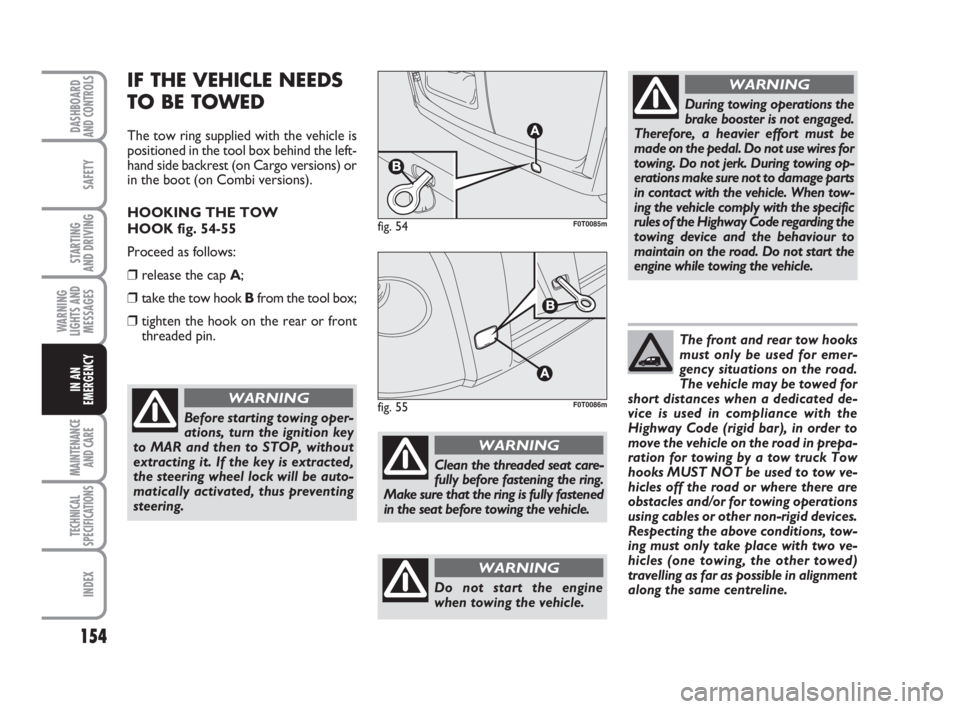
154
SAFETY
MAINTENANCE
AND CARE
TECHNICAL
SPECIFICATIONS
INDEX
DASHBOARDAND CONTROLS
STARTING
AND DRIVING
WARNING
LIGHTS AND
MESSAGES
IN AN
EMERGENCY
IF THE VEHICLE NEEDS
TO BE TOWED
The tow ring supplied with the vehicle is
positioned in the tool box behind the left-
hand side backrest (on Cargo versions) or
in the boot (on Combi versions).
HOOKING THE TOW
HOOK fig. 54-55
Proceed as follows:
❒release the cap A;
❒take the tow hook Bfrom the tool box;
❒tighten the hook on the rear or front
threaded pin.
fig. 54F0T0085m
fig. 55F0T0086m
Before starting towing oper-
ations, turn the ignition key
to MAR and then to STOP, without
extracting it. If the key is extracted,
the steering wheel lock will be auto-
matically activated, thus preventing
steering.
WARNING
During towing operations the
brake booster is not engaged.
Therefore, a heavier effort must be
made on the pedal. Do not use wires for
towing. Do not jerk. During towing op-
erations make sure not to damage parts
in contact with the vehicle. When tow-
ing the vehicle comply with the specific
rules of the Highway Code regarding the
towing device and the behaviour to
maintain on the road. Do not start the
engine while towing the vehicle.
WARNING
Clean the threaded seat care-
fully before fastening the ring.
Make sure that the ring is fully fastened
in the seat before towing the vehicle.
WARNING
Do not start the engine
when towing the vehicle.
WARNING
The front and rear tow hooks
must only be used for emer-
gency situations on the road.
The vehicle may be towed for
short distances when a dedicated de-
vice is used in compliance with the
Highway Code (rigid bar), in order to
move the vehicle on the road in prepa-
ration for towing by a tow truck Tow
hooks MUST NOT be used to tow ve-
hicles off the road or where there are
obstacles and/or for towing operations
using cables or other non-rigid devices.
Respecting the above conditions, tow-
ing must only take place with two ve-
hicles (one towing, the other towed)
travelling as far as possible in alignment
along the same centreline.
123-154 Fiorino GB 1ed:123-154 Fiorino GB 1ed 3-12-2009 15:34 Pagina 154
Page 156 of 210
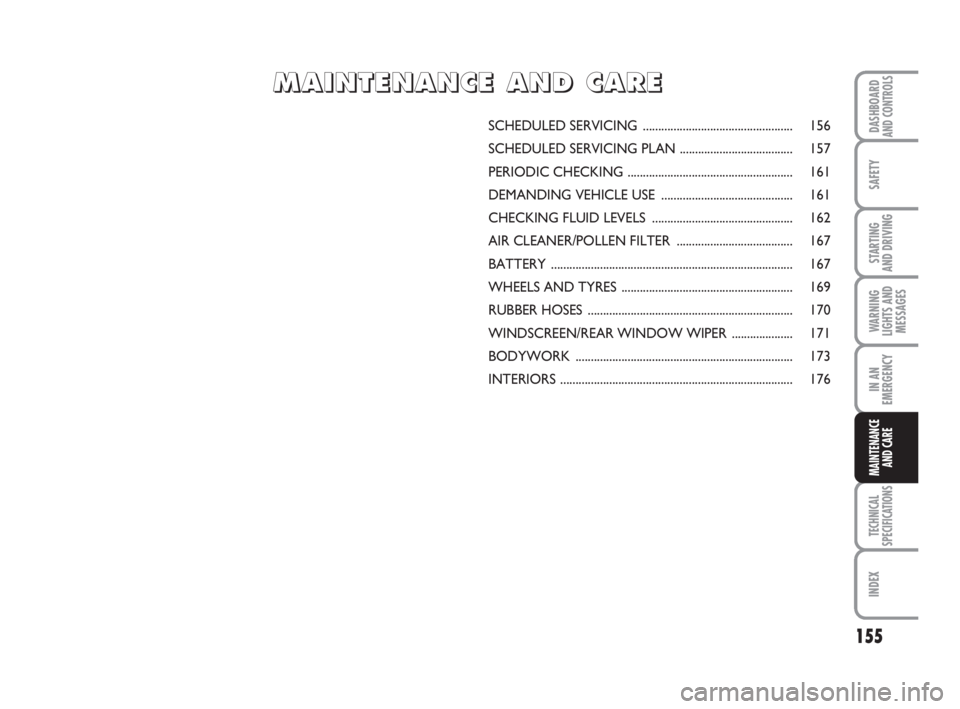
155
SAFETY
TECHNICAL
SPECIFICATIONS
INDEX
DASHBOARDAND CONTROLS
STARTING
AND DRIVING
WARNING
LIGHTS AND
MESSAGES
IN AN
EMERGENCY
MAINTENANCE
AND CARE
SCHEDULED SERVICING................................................. 156
SCHEDULED SERVICING PLAN ..................................... 157
PERIODIC CHECKING...................................................... 161
DEMANDING VEHICLE USE........................................... 161
CHECKING FLUID LEVELS.............................................. 162
AIR CLEANER/POLLEN FILTER ...................................... 167
BATTERY............................................................................... 167
WHEELS AND TYRES........................................................ 169
RUBBER HOSES................................................................... 170
WINDSCREEN/REAR WINDOW WIPER .................... 171
BODYWORK....................................................................... 173
INTERIORS ............................................................................ 176
M M
A A
I I
N N
T T
E E
N N
A A
N N
C C
E E
A A
N N
D D
C C
A A
R R
E E
155-176 Fiorino GB 1ed:155-176 Fiorino GB 1ed 30-11-2009 16:34 Pagina 155
Page 157 of 210
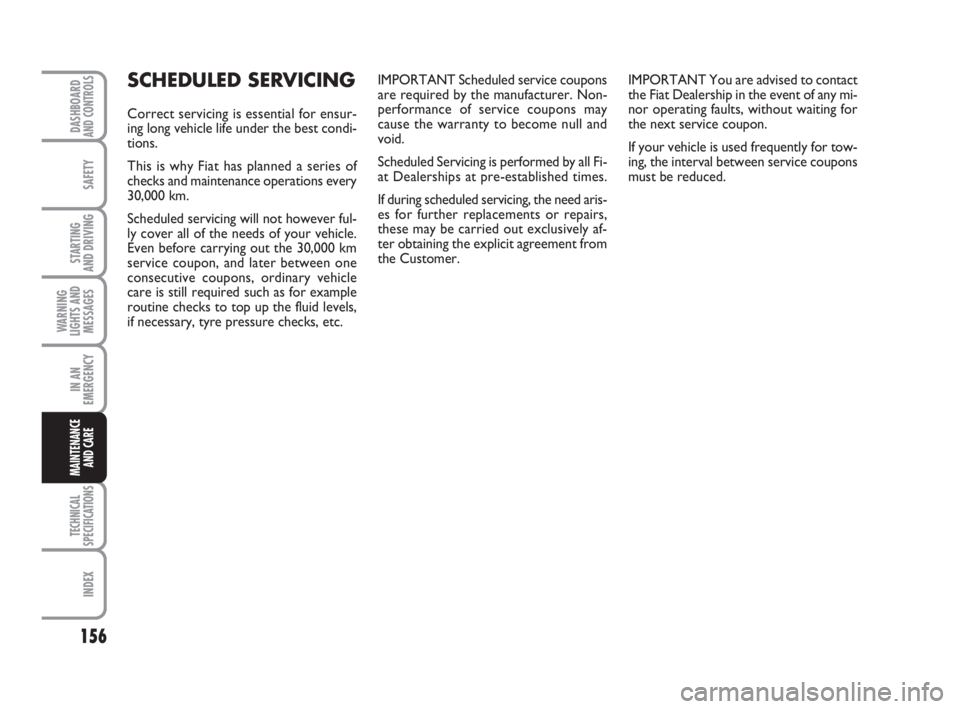
156
SAFETY
TECHNICAL
SPECIFICATIONS
INDEX
DASHBOARDAND CONTROLS
STARTING
AND DRIVING
WARNING
LIGHTS AND
MESSAGES
IN AN
EMERGENCY
MAINTENANCE
AND CARE
SCHEDULED SERVICING
Correct servicing is essential for ensur-
ing long vehicle life under the best condi-
tions.
This is why Fiat has planned a series of
checks and maintenance operations every
30,000 km.
Scheduled servicing will not however ful-
ly cover all of the needs of your vehicle.
Even before carrying out the 30,000 km
service coupon, and later between one
consecutive coupons, ordinary vehicle
care is still required such as for example
routine checks to top up the fluid levels,
if necessary, tyre pressure checks, etc.IMPORTANT Scheduled service coupons
are required by the manufacturer. Non-
performance of service coupons may
cause the warranty to become null and
void.
Scheduled Servicing is performed by all Fi-
at Dealerships at pre-established times.
If during scheduled servicing, the need aris-
es for further replacements or repairs,
these may be carried out exclusively af-
ter obtaining the explicit agreement from
the Customer.IMPORTANT You are advised to contact
the Fiat Dealership in the event of any mi-
nor operating faults, without waiting for
the next service coupon.
If your vehicle is used frequently for tow-
ing, the interval between service coupons
must be reduced.
155-176 Fiorino GB 1ed:155-176 Fiorino GB 1ed 30-11-2009 16:34 Pagina 156
Page 158 of 210
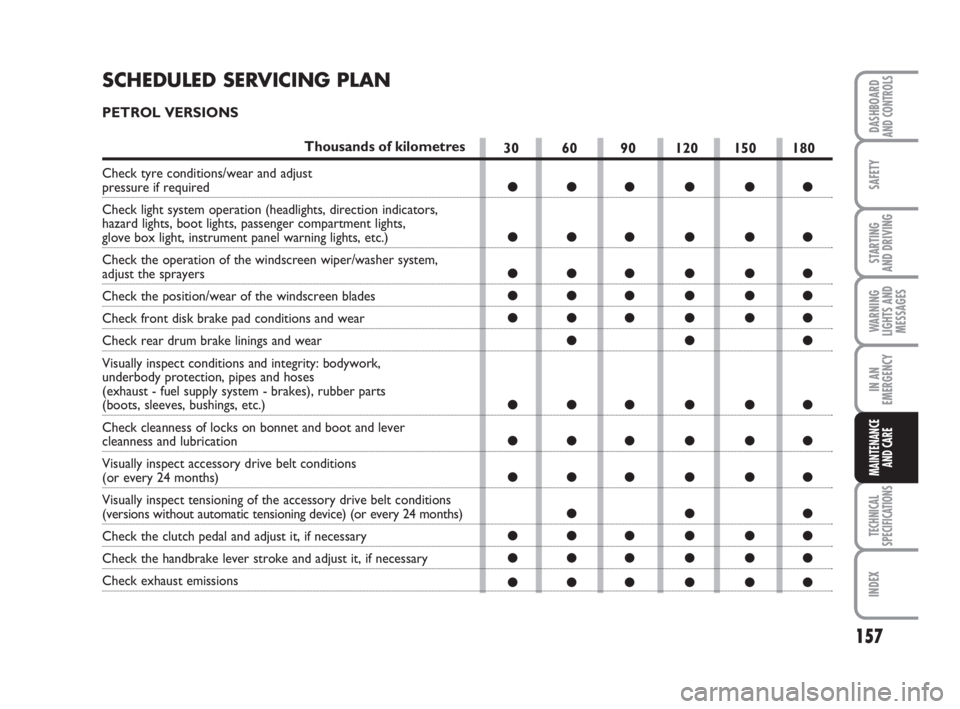
157
SAFETY
TECHNICAL
SPECIFICATIONS
INDEX
DASHBOARDAND CONTROLS
STARTING
AND DRIVING
WARNING
LIGHTS AND
MESSAGES
IN AN
EMERGENCY
MAINTENANCE
AND CARE
30 60 90 120 150 180
●●●●●●
●●●●●●
●●●●●●
●●●●●●
●●●●●●
●●●
●●●●●●
●●●●●●
●●●●●●
●●●
●●●●●●
●●●●●●
●●●●●●
SCHEDULED SERVICING PLAN
PETROL VERSIONS
Thousands of kilometres
Check tyre conditions/wear and adjust pressure if required
Check light system operation (headlights, direction indicators,
hazard lights, boot lights, passenger compartment lights,
glove box light, instrument panel warning lights, etc.)
Check the operation of the windscreen wiper/washer system,
adjust the sprayers
Check the position/wear of the windscreen blades
Check front disk brake pad conditions and wear
Check rear drum brake linings and wear
Visually inspect conditions and integrity: bodywork,
underbody protection, pipes and hoses
(exhaust - fuel supply system - brakes), rubber parts
(boots, sleeves, bushings, etc.)
Check cleanness of locks on bonnet and boot and lever
cleanness and lubrication
Visually inspect accessory drive belt conditions
(or every 24 months)
Visually inspect tensioning of the accessory drive belt conditions
(versions without automatic tensioning device) (or every 24 months)
Check the clutch pedal and adjust it, if necessary
Check the handbrake lever stroke and adjust it, if necessary
Check exhaust emissions
155-176 Fiorino GB 1ed:155-176 Fiorino GB 1ed 30-11-2009 16:34 Pagina 157
Page 159 of 210
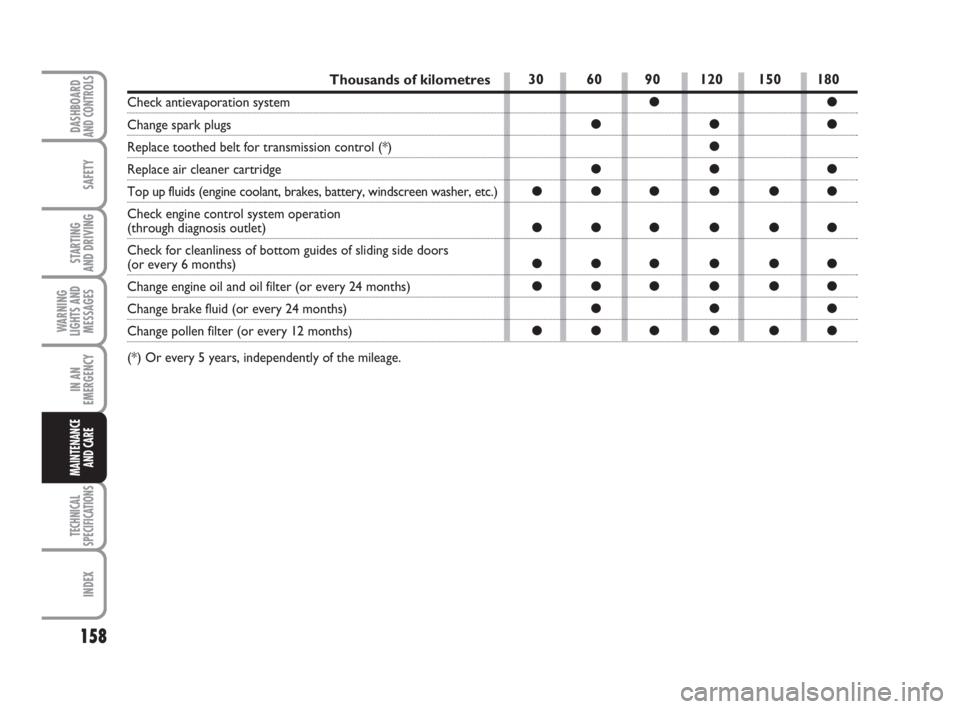
158
SAFETY
TECHNICAL
SPECIFICATIONS
INDEX
DASHBOARDAND CONTROLS
STARTING
AND DRIVING
WARNING
LIGHTS AND
MESSAGES
IN AN
EMERGENCY
MAINTENANCE
AND CARE
Thousands of kilometres
Check antievaporation system
Change spark plugs
Replace toothed belt for transmission control (*)
Replace air cleaner cartridge
Top up fluids (engine coolant, brakes, battery, windscreen washer, etc.)
Check engine control system operation
(through diagnosis outlet)
Check for cleanliness of bottom guides of sliding side doors
(or every 6 months)
Change engine oil and oil filter (or every 24 months)
Change brake fluid (or every 24 months)
Change pollen filter (or every 12 months)
(*) Or every 5 years, independently of the mileage.
30 60 90 120 150 180
●●
●●●
●
●●●
●●●●●●
●●●●●●
●●●●●●
●●●●●●
●●●
●●●●●●
155-176 Fiorino GB 1ed:155-176 Fiorino GB 1ed 30-11-2009 16:34 Pagina 158
Page 160 of 210
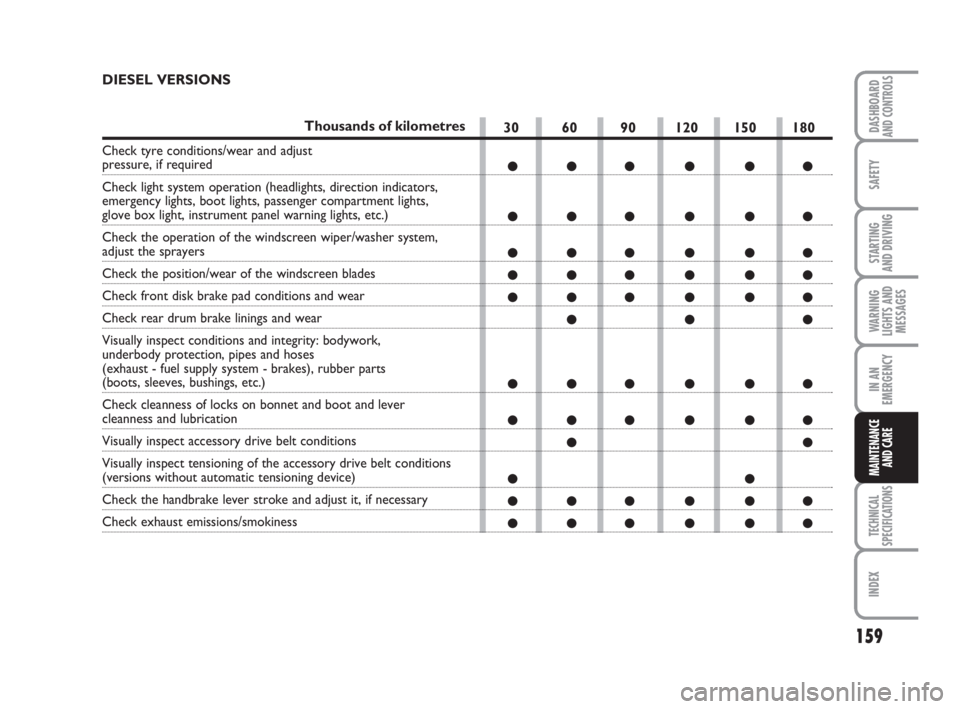
159
SAFETY
TECHNICAL
SPECIFICATIONS
INDEX
DASHBOARDAND CONTROLS
STARTING
AND DRIVING
WARNING
LIGHTS AND
MESSAGES
IN AN
EMERGENCY
MAINTENANCE
AND CARE
30 60 90 120 150 180
●●●●●●
●●●●●●
●●●●●●
●●●●●●
●●●●●●
●●●
●●●●●●
●●●●●●
●●
●●
●●●●●●
●●●●●●
DIESEL VERSIONS
Thousands of kilometres
Check tyre conditions/wear and adjust pressure, if required
Check light system operation (headlights, direction indicators,
emergency lights, boot lights, passenger compartment lights,
glove box light, instrument panel warning lights, etc.)
Check the operation of the windscreen wiper/washer system,
adjust the sprayers
Check the position/wear of the windscreen blades
Check front disk brake pad conditions and wear
Check rear drum brake linings and wear
Visually inspect conditions and integrity: bodywork,
underbody protection, pipes and hoses
(exhaust - fuel supply system - brakes), rubber parts
(boots, sleeves, bushings, etc.)
Check cleanness of locks on bonnet and boot and lever
cleanness and lubrication
Visually inspect accessory drive belt conditions
Visually inspect tensioning of the accessory drive belt conditions
(versions without automatic tensioning device)
Check the handbrake lever stroke and adjust it, if necessary
Check exhaust emissions/smokiness
155-176 Fiorino GB 1ed:155-176 Fiorino GB 1ed 30-11-2009 16:34 Pagina 159
Page 161 of 210
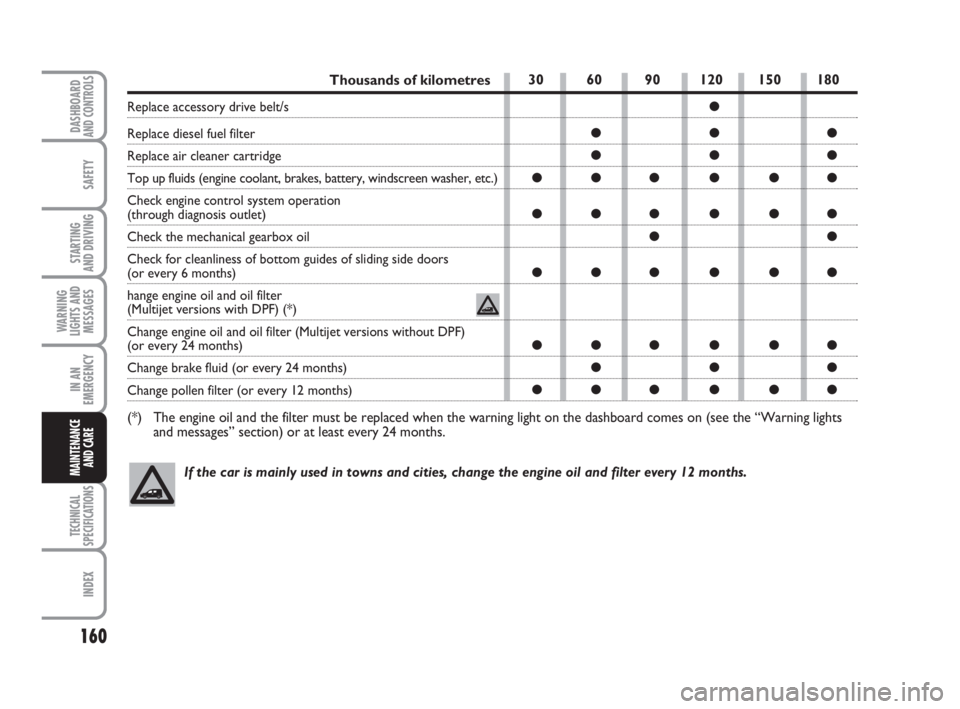
160
SAFETY
TECHNICAL
SPECIFICATIONS
INDEX
DASHBOARDAND CONTROLS
STARTING
AND DRIVING
WARNING
LIGHTS AND
MESSAGES
IN AN
EMERGENCY
MAINTENANCE
AND CARE
Thousands of kilometres
Replace accessory drive belt/s
Replace diesel fuel filter
Replace air cleaner cartridge
Top up fluids (engine coolant, brakes, battery, windscreen washer, etc.)
Check engine control system operation
(through diagnosis outlet)
Check the mechanical gearbox oil
Check for cleanliness of bottom guides of sliding side doors
(or every 6 months)
hange engine oil and oil filter
(Multijet versions with DPF) (*)
Change engine oil and oil filter (Multijet versions without DPF)
(or every 24 months)
Change brake fluid (or every 24 months)
Change pollen filter (or every 12 months)
(*) The engine oil and the filter must be replaced when the warning light on the dashboard comes on (see the “Warning lights
and messages” section) or at least every 24 months.
30 60 90 120 150 180
●
●●●
●●●
●●●●●●
●●●●●●
●●
●●●●●●
●●●●●●
●●●
●●●●●●
If the car is mainly used in towns and cities, change the engine oil and filter every 12 months.
155-176 Fiorino GB 1ed:155-176 Fiorino GB 1ed 30-11-2009 16:34 Pagina 160
Page 162 of 210
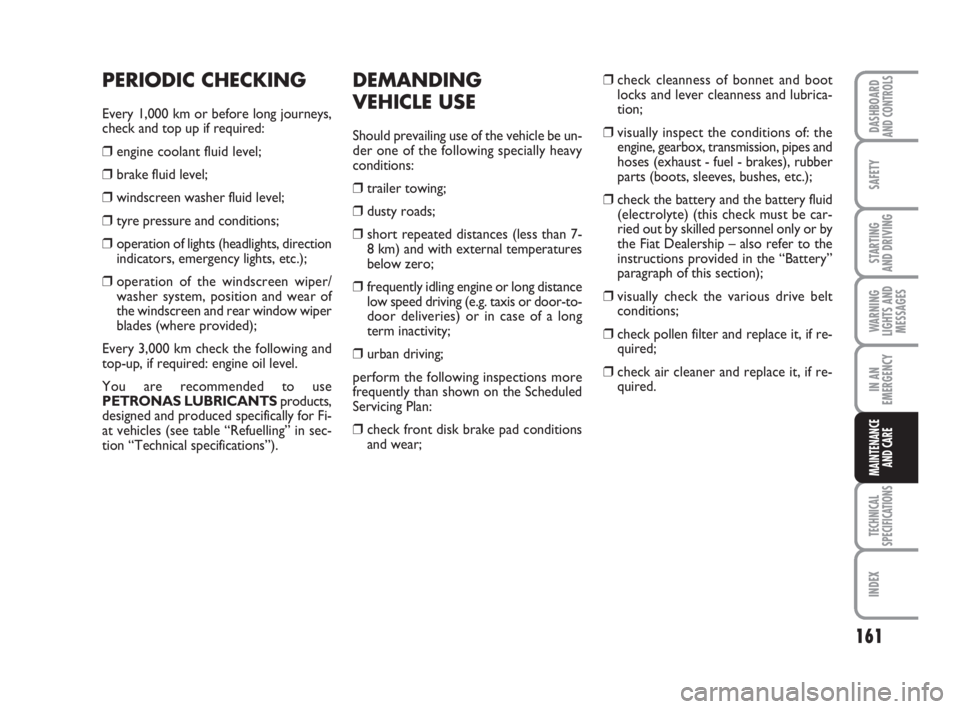
161
SAFETY
TECHNICAL
SPECIFICATIONS
INDEX
DASHBOARDAND CONTROLS
STARTING
AND DRIVING
WARNING
LIGHTS AND
MESSAGES
IN AN
EMERGENCY
MAINTENANCE
AND CARE
PERIODIC CHECKING
Every 1,000 km or before long journeys,
check and top up if required:
❒engine coolant fluid level;
❒brake fluid level;
❒windscreen washer fluid level;
❒tyre pressure and conditions;
❒operation of lights (headlights, direction
indicators, emergency lights, etc.);
❒operation of the windscreen wiper/
washer system, position and wear of
the windscreen and rear window wiper
blades (where provided);
Every 3,000 km check the following and
top-up, if required: engine oil level.
You are recommended to use
PETRONAS LUBRICANTSproducts,
designed and produced specifically for Fi-
at vehicles (see table “Refuelling” in sec-
tion “Technical specifications”).
DEMANDING
VEHICLE USE
Should prevailing use of the vehicle be un-
der one of the following specially heavy
conditions:
❒trailer towing;
❒dusty roads;
❒short repeated distances (less than 7-
8 km) and with external temperatures
below zero;
❒frequently idling engine or long distance
low speed driving (e.g. taxis or door-to-
door deliveries) or in case of a long
term inactivity;
❒urban driving;
perform the following inspections more
frequently than shown on the Scheduled
Servicing Plan:
❒check front disk brake pad conditions
and wear;❒check cleanness of bonnet and boot
locks and lever cleanness and lubrica-
tion;
❒visually inspect the conditions of: the
engine, gearbox, transmission, pipes and
hoses (exhaust - fuel - brakes), rubber
parts (boots, sleeves, bushes, etc.);
❒check the battery and the battery fluid
(electrolyte) (this check must be car-
ried out by skilled personnel only or by
the Fiat Dealership – also refer to the
instructions provided in the “Battery”
paragraph of this section);
❒visually check the various drive belt
conditions;
❒check pollen filter and replace it, if re-
quired;
❒check air cleaner and replace it, if re-
quired.
155-176 Fiorino GB 1ed:155-176 Fiorino GB 1ed 30-11-2009 16:34 Pagina 161
Page 163 of 210
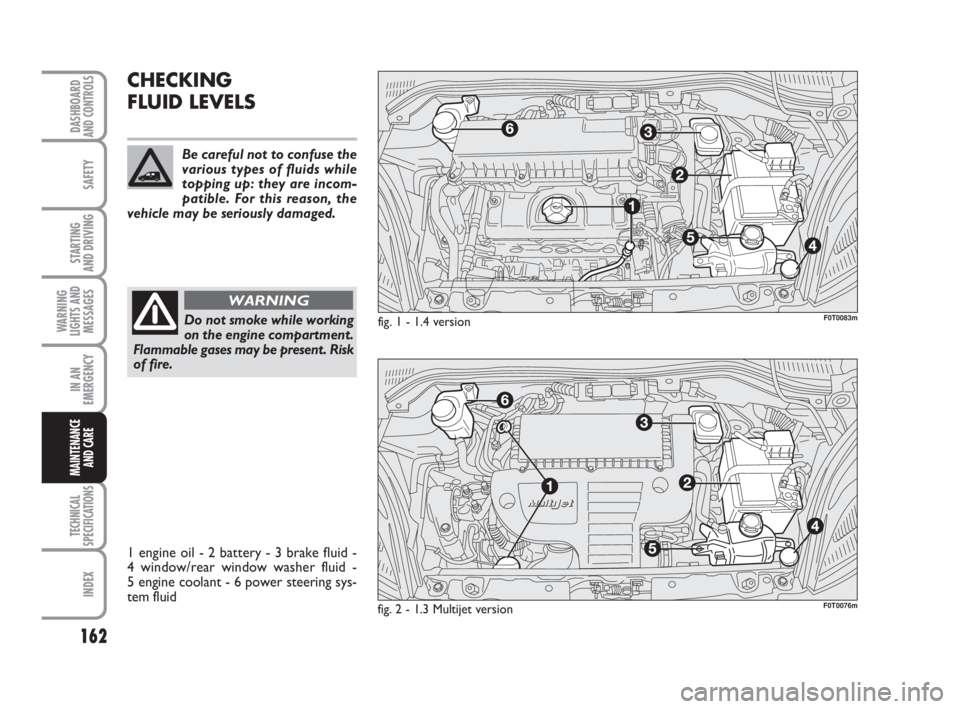
162
SAFETY
TECHNICAL
SPECIFICATIONS
INDEX
DASHBOARDAND CONTROLS
STARTING
AND DRIVING
WARNING
LIGHTS AND
MESSAGES
IN AN
EMERGENCY
MAINTENANCE
AND CARE
CHECKING
FLUID LEVELS
Do not smoke while working
on the engine compartment.
Flammable gases may be present. Risk
of fire.
WARNING
Be careful not to confuse the
various types of fluids while
topping up: they are incom-
patible. For this reason, the
vehicle may be seriously damaged.
fig. 1 - 1.4 version
fig. 2 - 1.3 Multijet versionF0T0083m
F0T0076m
1 engine oil - 2 battery - 3 brake fluid -
4 window/rear window washer fluid -
5 engine coolant - 6 power steering sys-
tem fluid
155-176 Fiorino GB 1ed:155-176 Fiorino GB 1ed 30-11-2009 16:34 Pagina 162
Page 164 of 210
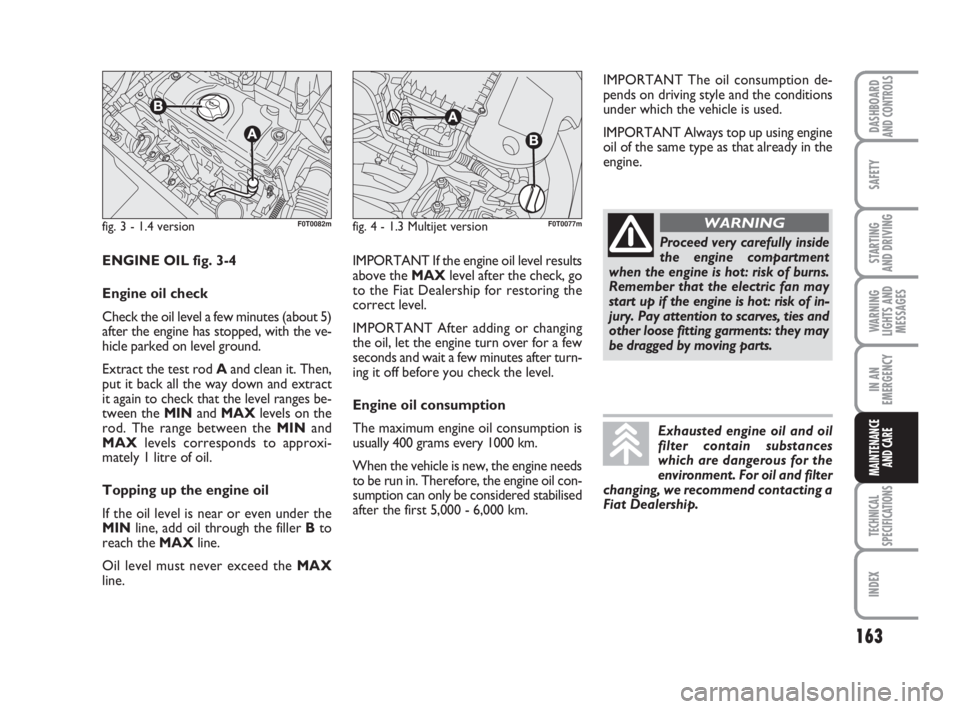
163
SAFETY
TECHNICAL
SPECIFICATIONS
INDEX
DASHBOARDAND CONTROLS
STARTING
AND DRIVING
WARNING
LIGHTS AND
MESSAGES
IN AN
EMERGENCY
MAINTENANCE
AND CARE
fig. 3 - 1.4 versionF0T0082mfig. 4 - 1.3 Multijet versionF0T0077m
IMPORTANT The oil consumption de-
pends on driving style and the conditions
under which the vehicle is used.
IMPORTANT Always top up using engine
oil of the same type as that already in the
engine.
ENGINE OIL fig. 3-4
Engine oil check
Check the oil level a few minutes (about 5)
after the engine has stopped, with the ve-
hicle parked on level ground.
Extract the test rod Aand clean it. Then,
put it back all the way down and extract
it again to check that the level ranges be-
tween the MINand MAXlevels on the
rod. The range between the MINand
MAXlevels corresponds to approxi-
mately 1 litre of oil.
Topping up the engine oil
If the oil level is near or even under the
MINline, add oil through the filler Bto
reach the MAXline.
Oil level must never exceed the MAX
line.
Proceed very carefully inside
the engine compartment
when the engine is hot: risk of burns.
Remember that the electric fan may
start up if the engine is hot: risk of in-
jury. Pay attention to scarves, ties and
other loose fitting garments: they may
be dragged by moving parts.
WARNING
Exhausted engine oil and oil
filter contain substances
which are dangerous for the
environment. For oil and filter
changing, we recommend contacting a
Fiat Dealership.
IMPORTANT If the engine oil level results
above the MAXlevel after the check, go
to the Fiat Dealership for restoring the
correct level.
IMPORTANT After adding or changing
the oil, let the engine turn over for a few
seconds and wait a few minutes after turn-
ing it off before you check the level.
Engine oil consumption
The maximum engine oil consumption is
usually 400 grams every 1000 km.
When the vehicle is new, the engine needs
to be run in. Therefore, the engine oil con-
sumption can only be considered stabilised
after the first 5,000 - 6,000 km.
155-176 Fiorino GB 1ed:155-176 Fiorino GB 1ed 30-11-2009 16:34 Pagina 163